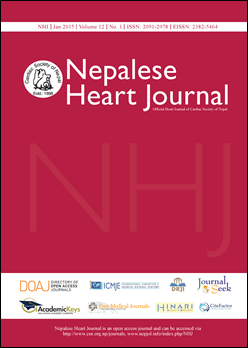Clinical Significance of ST Segment Depression in Lead aVR to Predict Culprit Artery in An Acute Inferior Wall Myocardial Infarction
DOI:
https://doi.org/10.3126/njh.v12i1.12324Keywords:
Inferior wall MI, Lead aVR, ST DepressionAbstract
Background and Aims: The main objective of this study is to analyze between left circumflex artery and right coronary artery as a presumptive predictor of a culprit artery in patients with an acute inferior wall ST elevation myocardial infarction according to ST segment change in lead aVR.
Methods: This study included 145 consecutive patients who presented with an inferior wall ST elevation myocardial infarction and underwent coronary angiography. Clinical and angiographic findings were compared between patients with and without aVR depression ≥ 0. 1mV.
Results: The sensitivity and specificity of ST segment depression in lead aVR to predict left circumflex artery as the culprit artery were 69% and 85%, respectively, and the positive predictive value and negative predictive value to predict left circumflex artery as the culprit arteries were 66% and 87%, respectively.
Conclusion: Our study supports, the presence of ST segment depression in lead aVR is associated with good specificity and negative predictive value and modest sensitivity and positive predictive value to determine left circumflex artery as an infarct related artery in an acute ST segment elevation inferior wall myocardial infarction.
DOI: http://dx.doi.org/10.3126/njh.v12i1.12324
Nepalese Heart Journal Vol.12(1) 2015: 5-9
Downloads
Downloads
Published
How to Cite
Issue
Section
License
This license enables reusers to distribute, remix, adapt, and build upon the material in any medium or format, so long as attribution is given to the creator. The license allows for commercial use.




